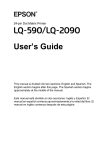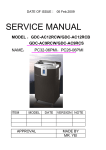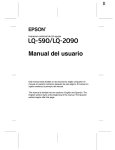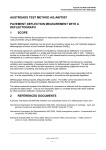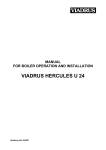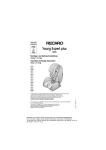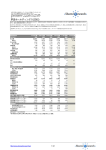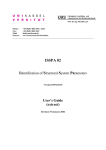Download MICRO-AIR RP8 Specifications
Transcript
MICRO-AIR DUST COLLECTOR Installation and Operation Manual MODEL RP6-2, RP-3, RP8-2 & RP-3 Important: This manual contains specific cautionary statements relative to worker safety. Read this manual thoroughly and follow as directed. It is impossible to list all the hazards of dust control equipment. It is important that use of the equipment be discussed with a Micro Air Representative. Persons involved with the equipment or systems should be instructed to operate in a safe manner. 1 TABLE OF CONTENTS CAUTIONS 3 SPECIFICATIONS 4 INSTALLATION INSPECTION EQUIPMENT / TOOLS REQUIRED ASSEMBLY OF UNIT COMPRESSED AIR INTALLATION ELECTRICAL INSTALLATION UNITS INSTALLED OUTDOORS UNIT OPERATION CARTRIDGE CLEANING OPERATION ROTO-PULSE CLEANING TIMER ADJUSTMENTS AFTER-PULSE CLEANING TIMER ADJUSTMENTS 5 5 5 6 7 7 7 7 8 8 OPTIONAL COMPONENT INSTALLATION DUST COLLECTION TRAY INSTALLATION PROCEDURE DUST COLLECTION HOPPER INSTALLATION PROCEDURE DUST COLLECTOR LEG BRACING INSTALLATION PROCEDURE MAGNEHELIC KIT INSTALLATION PROCEDURE PHOTOHELIC KIT INSTALLATION PROCEDURE BARREL LID KIT INSTALLATION PROCEDURE TOP MOUNTED BLOWER INSTALLATION PROCEDURE 9 10 11 12 13 14 15 WIRING DIAGRAMS RP6-2 WIRING DIAGRAM RP6-3 WIRING DIAGRAM RP8-2 WIRING DIAGRAM RP8-3 WIRING DIAGRAM 16 17 18 19 RP PARTS LIST 20 2 All wiring must be done in accordance with applicable National, State, and local electrical code. MicroAir does not determine what is acceptable in any local jurisdiction and cannot be held responsible for wiring that does not meet local codes. Cautions: Avoid mixing combustible materials, such as buffing lint, paper, wood, aluminum, and magnesium dust, and with dust generated from grinding ferrous metals due to the potential fire hazard caused by sparks in the dust collector. Improper installation or operation of this equipment can cause damage to equipment and / or injury to personell. The installation/operation manual must be read and followed in its entirety. Under no conditions should the persons operating the dust collector be allowed to put cigarettes or any burning object into the hood or ducting of any dust collector system. All users of Micro-Air Dust Collector Equipment should comply with all National and Local Fire Codes and/or other appropriate codes when determinimg the location and operation of dust control equipment. Many of the processes outlined in this manual will expose the installer to circuits powered by high voltage. This installation is recommended for professional electricians or MicroAir trained personnel. When dust collectors are used to collect flammable or explosive dusts, the dust collector should be located outside the building. Also, an installer of fire extinguisher equipment, familiar with this type of fire hazard and local fire codes, should be consulted for recommendations and installation of the proper fire extinguishing equipment. Dust collectors do not contain fire extinguishing equipment. Explosion relief vents are required on some applications. Consult with an insurance underwriter or a NFPA manual to determine proper vent size ratio. Vents installed on dust control equipment within a building, must be vented to the outside to minimize changes of secondary explosion. Consult the proper authority having jurisdiction to determine proper method of venting. Dust collectors do not contain Explosion Relief Vents, except on special order. 3 Specifications: RP6-2 & RP8-2: 2 ea. Cust Collection Tray/Hopper 6 ea. Mounting Legs Input Voltage: 120 Volt Cabinet Dimensions: RP6-2 RP6-3 RP8-2 RP8-3 RP6-3 & RP8-3: 3 ea. Cust Collection Tray/Hopper 8 ea. Mounting Legs 151” H x 84” W x 56” D 151” H x 126” W x 56” D 173” H x 84” W x 56” D 173” H x 126” W x 56” D Weight: RP6-2 RP6-3 RP8-2 RP8-3 2318 lb. 3477 lb. 3098 lb. 4647 lb. Filter Area: RP6-2 RP6-3 RP8-2 RP8-3 3492 square feet 5238 square feet 4656 square feet 6984 square feet Additional equipment that may be shipper seperaly includes: 55 Gallon Barrel Lid Kit & Explosion Kit. RP6-2 & RP8-2 10 ea. Cross Leg Braces 2 ea. Mounting Hardware Packages Containing: 12 ea. 5/16 Hex Bolts 12 ea. 5/16 Flat Washers 12 ea. 5/16 Lock Washers 20 ea. Self-Tapping Screws 11 ft. Self Adhesive Foam Air Recuirements: • 1.1 SCFM at 80 psi per second of cleaning pulse: 5.4 scfm total. • Minimum air line 3/4 inch at 80 psi maximum. • 3/4” NPT Female fitting is standard for shop air attachment. • Clean, dry, compressed air at the correct pressure is required for the cleaning system to operate correctly. It is recommended that a pressure regulator and coalescing filter be installed between the copressed air source and the inlet to the dust collector. RP6-3 & RP8-3 14 ea. Cross Leg Braces 3 ea. Mounting Hardware Packages Containing: 12 ea. 5/16 Hex Bolts 12 ea. 5/16 Flat Washers 12 ea. 5/16 Lock Washers 20 ea. Self-Tapping Screws 11 ft. Self Adhesive Foam Installation: Crane or Lift Truck Lift Straps or Chain 1/2” Scocket Wrench Pipe Wrench Equipment/Tools Required: Equipment and tools needed for proper installation will include the following: Inspection: The Micro-Air Dust Collector is shipped on two skids. Both skids should be inspected for any visible damage that may have occurred during shipment. One skid is the blower motor and collector cabinet. The other skid will have the following: 4 2. Lift the unit with a lift truck or overhead crane using the four lifting lugs located at the corners of the unit (see Figure 1 & 2). Assembly of Unit: 1. Determine the location where the unit is to be installed. Be sure to allow sufficient room to access the unit for servicing and maintenance on all sides. 3. Bolt on each of the legs. The two lower bolts at each corner will be removed and used to attach each corner leg (see Figure 3). Attach middle legs with provided hardware (see Figure 4). 4. When the legs have been completely installed each leg should be bolted to the ground suing the hole provided in the base plate of the leg (see Figure 5). 5. After the legs have been properly anchored, the dust containment system can be installed. CAUTION: THE UNIT IS NOT DESIGNED TO BE OPERATED WHILE HANGING FROM LIFTING BRACKETS. UNIT MUST BE MOUNTED ON LEGS AND CROSS BRACING INSTALLED. FIGURE 1 FIGURE 2 CAUTION: THE UNIT SHOULD BE LIFTED OFF THE SKID AND SET INTO POSITION BY UTILIZING THE LIFTING LUGS PROVIDED. SEVER DAMAGE MAY RESULT FROM ANY OTHER LIFTING METHOD. FIGURE 3 5 FIGURE 4 MIDDLE LEG 1/2” DIA. HOLES COMPRESSED AIR INLET 3/4” FEMALE NPT BASE PLATE FIGURE 5 Compressed Air Installation The compressed air inlet for the Roto-Pulse cleaning system is at the top of the piping assembly located on the backside of the unit (see Figure 6). A minimum of a 3/4 inch line and plant air at a pressure at 80 psi is required for proper operation of the Roto-Pulse cleaning system. A single 3/4” air line, branched to each manifold, is sufficient to the entire unit. NOTE: Clean, dry, compressed air at the correct pressure is required for the cleaning system to operate correctly. It is recommended that a pressure regulator and coalescing filter be installed between the compressed air source and the inlet to the dust collector. FIGURE 6 6 Electrical Installation Unit Operation 1. Turn the blower on. This action will cause the filter unit to activate and start cleaning filters. NOTE: All electrical work must be done by a qualified electrician. NOTE: Some particulate may pass through the cartridge filters and blower upon initial start-up. This will end once the filters have been seasoned and a power cake has formed on the filter. If this condition continues to occur, refer to the section “Roto-Pulse Cleaning Timer Adjustments” to increase the period of time between pulses. CAUTION: Installation can cuase exposure to live components. Disconnect electrical power befor proceeding with installation. Proper lock out/tag out procedures should be used. 1. Open the electrical box cover located on the side of the unit. Make connections from your 120V supply power to terminal L, N and G (see figure 7). 2. once the unit is running the Roto-Pulse cleaning system will be operational. Operation is detected by hearing a .07-second air pulse approximately every 5 seconds. If adjustment to timing of pulses is desired refer to the secion “Roto-Pulse Cleaning Timer Adjustments”. 2. When supply power has been terminated, reconnect the power. Momentarily turn the remote blower on and adjust pressure switch via set screw until contact is made. Use ohm meter to measure continuity across the pressure switch. 3. Check the After-Pulse Cleaning cycle by turning off the unit via the stop switch located on the side of the electrical box. The unit should continue to pulse every 5 seconds for a period of approximately 17 minutes. If adjustment to the after-pulse time is desired, refer to the section labeled “After-Pulse Cleaning”. POWER CONNECTION SET SCREW Cartridge Cleaning Operation PRESSURE SWITCH The Micro Air Dust Collector is designed with the Roto-Pulse Cleaning System to clean the cartridge filters. This system provide superior cleaning performance using a rotating tube with pre-drilled holes (see Figure 8). As the diaphragm valve opens, the RotoPulse tube rotates while air exits the holes, thus providing the cleaning of the cartridge. ROTO-PULSE TUBE TIMER BOARD FIGURE 7 FIGURE 8 7 differential across the filters. If you can not maintain this minimum level of differential across the filters the time between cleaning pulses should be increased until this can be achieved. 1. For proper cleaning, the compressed air pressure should be regulated at 80 psi maximum. 2. During normal operation the Roto-Pulse cleaning system is factory set to clean two (2) cartridge filters for a period of .07 seconds every 5 seconds. 3. Once the unit is turned off, the cleaning cycle will continue for a period of 17 minutes. Do not service the filters until cleaning is completed. 4. The timer control board is preset at the factory to have a cleaning pulse duration of .07 seconds. This can be adjusted from .05 seconds to 600 seconds. the timer board untill the on time LED is lit. Press the up/down buttons untill the desired value is displayed. Press select to set the new value. CAUTION: Allow 20 minutes of downtime before opening filter access doors. After-Pulse system is momentarily operational After unit is turned off. NOTE: While this time can be adjusted we recommend that you leave the “ON TIME” at the factory setting. If less cleaning is needed you should increase the time between pulses as means of reducing the amount of cleaning. If more cleaning is needed you should decrease the amount of time between pulses. Beware, as the time between pulses is decreased for additional cleaning, this will increase your compressed air consumption and create an additional load on your compressed air system. 4. The Roto-Pulse cleaning operation dislodges particles from the cartridges. Particles then fall down into the dust hopper and collection hopper. 5. After continued use of the unit, the dust collection barrel will need to be removed and emptied. The frequency of servicing will vary depending on the type and quantitiy of dust that is collected. The dust collection barrel should be emptied when the barrel reaches half full (Dependent on weight of material being collected.) 5. once adjustments have been made replace the electrical box cover and reconnect the power. 6. Start the unit and observe the new pulse settings and determine if additional adjustments are necessary. If more adjusting is needed, repeat the previous steps. NOTE: When servicing the collection system, be sure to turn the unit off. Roto-Pulse Cleaning Timer Adjustments After-Pulse Cleaning Timer Adjustments 1. Turn unit off via the stop switch and disconnect power. 2. Remove the electrical box cover. 3. The timer control board is present at the factory to clean two (2) cartridge filters every 5 seconds. This time can be adjusted from 1 second to 999 seconds. To adjust this time press the select button on the timer board untill the off time LED is lit. Press the up/down buttons untill the desired value is displayed. Press select to set the new value. 1. The unit is equipped with an After-Pulse Cleaning Cycle. This cycle will continue to clean the cartridge filters for a period of time after the unit is turned off. 2. The length of the After-Pulse operation is preset at the factory for 999 seconds (17 minutes). This time can be adjusted from 0 seconds to 999 seconds. To adjust this time press the select button untill the off time LED is lit. Press and hold the select button for 3 seconds. Press the up/down buttons untill the desired value is displayed. Press select to set the new value. The after-pulse operation can be disabled by setting the time value to zero (0) seconds. NOTE: Cleaning of the filters too often will decrease your level of performance. A certain level of dust cake on the filters will improve the efficiency of the filter cartridges. You should try to maintain a minimum of 1 in w.c. of pressure 8 RP DUST COLLECTOR DUST COLLECTION TRAY INSTALLATION PROCEDURE Each Kit Includes: 20 ea. 12 ft. 86 in. 1 ea. 2 ea. 1 ea. 2 ea. P3543 P3686 P1367 38379-01 38380-01 38378-01 P1372 Self-Tapping Screws 3/16” x 1” Self-Adhesive Foam 1” x 3/4” Foam (Placed at inside of Access Door) Dust Tray Weldment Dust Tray Dust Tray Access Door Door Latch NOTE: Dust tray access door must be removed prior to assembly INSTALLATION: 1. Apply self-adhesive foam to the bolt hole flange on the dust tray. 2. Align the hole pattern on the dust tray flanges with the hole pattern on the underside ot the unit. 3. Attach the dust tray (38379-01), usting twenty (20) self-tapping screws, to the unit. SELF-ADHEASIVE FOAM SELF-TAPPING SCREWS DUST TRAY ACCESS DOOR DOOR LATCH HANDLE FIGURE 9 9 DUST TRAY WELDMENT RP DUST COLLECTOR DUST COLLECTION HOPPER INSTALLATION PROCEDURE Each Kit Includes: 20 ea. 12 ft. 1 ea. P3543 P3686 38222-01 Self-Tapping Screws 3/16” x 1” Self-Adhesive Foam Hopper Weldment INSTALLATION: 1. Apply self-adhesive foam to the bolt hole flange on the hopper. 2. Align the hole pattern on the hopper flanges with the hole pattern on the underside ot the unit. 3. Attach the hopper (38222-01), usting twenty (20) self-tapping screws, to the unit. SELF-ADHEASIVE FOAM SELF-TAPPING SCREWS HOPPER WELDMENT FIGURE 10 10 RP DUST COLLECTOR DUST COLLECTOR LEG BRACING INSTALLATION PROCEDURE Each Kit Includes: 15 ea. 15 ea. 30 ea. 30 ea. 2 ea. 4 ea. P222 P2614 P3615 P249 38394-01 38394-02 5/16” Hex Nuts 5/16” Hex Bolts 5/16” Flat Washers 5/16” Lock Washers Short Leg Cross Brace Long Leg Cross Brace INSTALLATION: 1. Straighten and plumb each individual leg. 2. Bolt each end of the cross braces to the legs. 3. Tighten all bolts until secure. FIGURE 11 11 RP DUST COLLECTOR AFTERMARKET MAGNEHELIC KIT INSTALLATION PROCEDURE This Kit Includes: 1 ea. 1 ea. 2 ea. 4 ea. 10 ft. 38294-01 P3755 P2098 P3543 P1848 Magnehelic Mounting Bracket 0-10” w.c. Magnehelic Gauge 1/8” Male x 1/4” Barb Fitting 1/4”-14 x 1 Self-taping Screw 1/4” Clear Tubing INSTALLATION: 1. Remove parts from package and inspect for any possible damage incurred during shipping. 2. Turn off dust collector and disconnect power to the unit. 3. Mount the Magnehelic Gauge into the Magnehelic Mounting Bracket and place the (2) male barb fittings in the pressure ports located on the side of the Magnehelic Gauge. 4. Take the two pressure port plugs supplied with the Magnehelic Gauge on the two ports located on the back side of the gauge. 5. Mount the bracket using the (4) 1/4” self-taping screws. 6. Using 1/4” clear tubing (Additional length can be purchased) connect the “LOW” pressure port on the gauge to the clean air plenum and “HIGH” pressure port to the dirty air plenum. 7. Reconnect the power to the unit and start the dust collector. FIGURE 12 12 RP DUST COLLECTOR PHOTOHELIC KIT INSTALLATION PROCEDURE This Kit Includes: 1 ea. 1 ea. 2 ea. 4 ea. 10 ft. 38293-01 P3643 P2098 P3543 P1848 Photohelic Mounting Bracket 0-10” w.c. Photohelic Gauge 1/8” Male x 1/4” Barb Fitting 1/4”-14 x 1 Self-taping Screw 1/4” Clear Tubing NOTE: When using a Photohelic on a dust collector installed outdoors, the gauge can not be mounted on the unit. It must be mounted indoors. The gauge is not rated for outdoor use. INSTALLATION: 1. Remove parts from package and inspect for any possible damage incurred during shipping. 2. Turn off dust collector and disconnect power to the unit. 3. Remove the plastic cover on the back of Photohelic Gauge. 4. Mount the Photohelic Gauge into the Photohelic Mounting Bracket and place the (2) male barb fittings in the pressure ports located on the side of the Photohelic Gauge. 5. Remove cover from electrical box so that wiring diagram on back of cover can be used. 6. Remove the two red wires that are connected to the Timer Board Pressure Switch Input and Relay CR1. 7. Wire the Photohelic Gauge as the electrical diagram shows in Detail “A” (see page 10) using the 3/4” conduit opening on the Photohelic and the 3/4” knockout located on the electrical box. (Wire and conduit supplied by others.) 8. Replace the cover back onto the Photohelic Gauge and mount the bracket using the (4) 1/4” self-taping screws. 9. Using 1/4” clear tubing (Additional length can be purchased) connect the “LOW” pressure port on the gauge to the clean air plenum and “HIGH” pressure port to the dirty air plenum. 10. You must place the enable/disable switch located on the timer board to the “DISABLE” position. This will disable the after-pulse mode of the timer board. 11. Replace the cover on the electrical box and reconnect the power to the unit. 12. The right set point dial of the gauge should be positioned at the filter differential set point you want the Roto-pulse system to be enabled. The left should be positioned at the filter differential set point you want the Roto-pulse system disabled. FIGURE 13 13 RP DUST COLLECTOR BARREL LID KIT INSTALLATION PROCEDURE Each Kit Includes: 1 ea. 1 ea. 4 ea. 38198-01 P3966 P3119 Adapet Plate Barrel Lid and Duct Kit 3/8-16 x 1” Hex Head Bolt 8 ea. P2206 4 ea. P141 4 ea. P142 Flat Washer 3/8-16 Nut Lock Washer INSTALLATION: 1. Remove parts from box and inspect for any possible damage incurred during shipping. 2. Bolt Adapter Plate and Hopper Adapter to the Hopper using the 3/8” hardware. 3. Clamp the Pipe Section to the Barrel Lid.. 4. Slide the Pipe Section over the Hopper adapter and adjust so that the Barrel lid is resting on the Barrel. 5. Roll the gasket down until it is resting on the flange of the Pipe Section 6. Clamp the Pipe secion and gasket together. DUST COLLECTOR HOPPER ADAPTER PLATE HOPPER ADAPTER GASKET CLAMP PIPE SECTION CLAMP BARREL LID BARREL (BY OTHERS) FIGURE 14 14 RP DUST COLLECTOR TOP MOUNTED BOLWER INSTALLATION PROCEDURE This Kit Includes: 12 ea. 12 ea. 12 ea. P142 P2206 P3119 3/8” Split-lock Washers 3/8” Flat Washers 3/8” - 16 x 1” Hex Head Bolts Equipment Required: Chain Lift Truck or Crane 9/16” Wrench INSTALLATION: 1. Remove parts from the cloth bag. 2. Turn off dust collector and disconnect power to the unit. 3. Carefully lift the blower and position it over the adapter plate. 4. Align and lower the blower to the top of the adapter plate. 5. Start all 12 bolts through the blower flange into the adapter plate. 6. Tighten the bolts until secured. 7. Attach wiring per blower manufacturer’s literature. FIGURE 15 15 RP6-2 WIRING DIAGRAM FIGURE 16 16 RP6-3 WIRING DIAGRAM FIGURE 17 17 RP8-2 WIRING DIAGRAM FIGURE 18 18 RP8-3 WIRING DIAGRAM FIGURE 19 19 RP PARTS LIST - CABINET FIGURE 20 ITEM PART NO. DESCRIPTION ITEM PART NO. DESCRIPTION 1 36720-11 Filter Support Assembly (Roto-Pulse) 16 P3734 1/4” O.D. Air Hose 2 P3649 4-Prong Knob 17 P3744 12 Pilot Valve Enclosure 3 39034-01 End Cap Assy. (Including Door Seal) N.S. P3657 8 Pilot Valve Enclosure 4 38342-01 Door Seal N.S. P3656 6 Pilot Valve Enclosure P7400RM 80/20 Cellulose Cartridge Filter 250sf N.S. P3784 9 Pilot Valve Enclosure P7402RM 80/20 Cellulose Cartridge Filter 291sf N.S. 39029-01 Solenoid Repair Kit P7404RM Spun Bound Polyester Cartridge Filter 18 P3874 Timer Board P7405HO Treated Spun Bound Polyester Cartridge 19 P3505 Pressure Switch 6 P3314 Washer N.S. 38297-01 MAGNEHELIC Kit 7 P3559 Rubber Washer N.S. 38425-01 PHOTOHELIC Kit 8 P2209 3/4” Close Nipple N.S. 38284-01 Barrel Lid Kit 9 P3563 3/4” Galvanized Tee 20 P3559 Disk Pad (small) 10 P3411 1” Hose Clap 21 P3594 3/8” x 1/2” x 3/8” Bearing 11 P3403 5/8” Air Hose 22 P2286 Nylon Shoulder Washer 12 P3585 3/4” NPT x 5/8” Barb 23 P2285 Compression Spring N.S. 38344-01 (2) Valve Manifold 24 P2284 Pivot Bolt N.S. 38344-02 (3) Valve Manifold 25 36713-06 Filter Support Weldment P249 5/16” Lock Washer Pltd. 5/16” - 18 Pltd. Hex Nut 5 13 38344-03 (4) Valve Manifold 26 14 38343-01 1” Diaphragm Valve 27 P222 14A P3098 Diaphragm Seal 28 36730-06 Roto Tube Weldment N.S. P3099 Diaphragm Kit 29 P3413 1/2” Male x 5/8” Barb 15 P3735 1/4” 90 deg. Presto Lock 30 P3595 17/32” x 5/8” x 3/4” Bearing 20 FIGURE 21 FIGURE 22 21 Notes: Date of Install: ________________________________________________________ Installer: ________________________________________________________ ______________________________________________________________________________________ ______________________________________________________________________________________ ______________________________________________________________________________________ ______________________________________________________________________________________ ______________________________________________________________________________________ ______________________________________________________________________________________ ______________________________________________________________________________________ ______________________________________________________________________________________ ______________________________________________________________________________________ ______________________________________________________________________________________ ______________________________________________________________________________________ ______________________________________________________________________________________ ______________________________________________________________________________________ ______________________________________________________________________________________ ______________________________________________________________________________________ ______________________________________________________________________________________ ______________________________________________________________________________________ ______________________________________________________________________________________ ______________________________________________________________________________________ L1547 3/31/11 22























